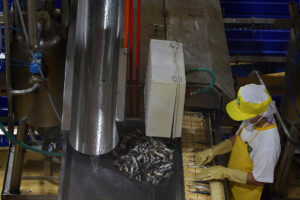Factory activity at 2-year high in Sept.
PHILIPPINE MANUFACTURING ACTIVITY continued to expand in September, hitting its highest in two years and outperforming its peers in Southeast Asia, S&P Global said in a report. The Philippine Manufacturing Purchasing Managers’ Index (PMI) rose to 53.7 in September, from 51.2 in August. It was the fastest reading since the 53.8 clip in June 2022. […]

PHILIPPINE MANUFACTURING ACTIVITY continued to expand in September, hitting its highest in two years and outperforming its peers in Southeast Asia, S&P Global said in a report.
The Philippine Manufacturing Purchasing Managers’ Index (PMI) rose to 53.7 in September, from 51.2 in August. It was the fastest reading since the 53.8 clip in June 2022.
“The Filipino manufacturing sector showed a significant improvement at the end of the third quarter, as indicated by the latest PMI data,” Maryam Baluch, economist at S&P Global Market Intelligence, said in a report.
 An above 50 PMI reading shows better operating conditions than in the last month.
An above 50 PMI reading shows better operating conditions than in the last month.
The Philippines’ PMI — a composite single-figure indicator of manufacturing performance — has posted an above 50 reading every month since September 2023.
The Philippines’ PMI reading was the highest among five Association of Southeast Asian Nations (ASEAN) countries in September. It was ahead of Thailand, which posted a 50.4 reading.
On the other hand, Malaysia (49.5), Indonesia (49.2), Vietnam (47.3) and Myanmar (45.5) showed contractions.
Philippine PMI was also above the region’s average of 50.5, S&P Global said.
The headline PMI measures manufacturing conditions based on the weighted average of five indices — new orders (30%), output (25%), employment (20%), suppliers’ delivery times (15%) and stocks of purchases (10%).
S&P Global said the strong expansion in new orders fueled a rise in production volume, which also boosted hiring and purchasing activity.
“The respective seasonally adjusted indexes signaled a quicker pace of growth on the month, ticking up to a 20- and 10-month high, respectively. Anecdotal evidence pointed to improving underlying demand trends, new client wins and the successful launch of new products,” it said.
Despite the increase in new orders, Ms. Baluch noted that demand for Filipino goods have dropped “notably” in international markets.
New export orders for Filipino goods have dropped for a second straight month in September, “with the latest downturn the most severe in over four years,” S&P Global said.
“While weak international demand and supply-chain issues will act as headwinds, robust domestic demand is expected to drive growth,” Ms. Baluch noted.
S&P Global said manufacturers increased their hiring and purchasing activities in September to cope with the overall rise in new orders.
“The rate of employment growth, though modest, was the strongest since March. Nonetheless, growing levels of new work fed through to a rise in backlogs of work in September, thereby marking a first month of accumulation since May 2023,” S&P Global said.
In September, buying activity hit a 20-month high, as some firms expect more sales in the next few months and “to protect themselves from predicted supply-chain disruptions.”
However, S&P Global noted the drop in vendor performance was also the biggest since December 2022.
“Inflationary pressures also intensified in September, with firms attributing this to higher supplier prices and weather events,” it said, adding that the rate of input price inflation rose to a seven-month high.
“Price pressures also rose due to supplier charge increases and recent weather events affecting raw material costs. However, inflationary pressures remain historically subdued, which supports the central bank’s recent decision to ease monetary policy,” Ms. Baluch said.
Looking ahead, firms remained confident of the manufacturing sector’s performance in the coming months, with their confidence level the highest since May.
Manufacturers also expect demand trends will still improve, which will support production growth.
“Operational efficiencies and a better interest rate environment might have contributed to improved manufacturing performance,” Terry L. Ridon, a public investment analyst and convenor of think tank InfraWatch PH, said in a Viber message.
In August, the Monetary Board cut interest rates for the first time in nearly four years. It reduced the benchmark rate by 25 basis points to 6.25% from the over 17-year high of 6.5%.
Leonardo A. Lanzona, who teaches economics at the Ateneo de Manila University, said external headwinds had affected demand for Philippine-made goods in the international market.
“Shocks, including war, climate change, geopolitical tensions, resurgent nationalism and growing focus on national security have resulted in inflationary pressures, rising costs of capital, fiscal distress and declining fiscal space, and challenges in meeting sustainability goals,” he said in a Facebook Messenger chat. — Beatriz Marie D. Cruz























